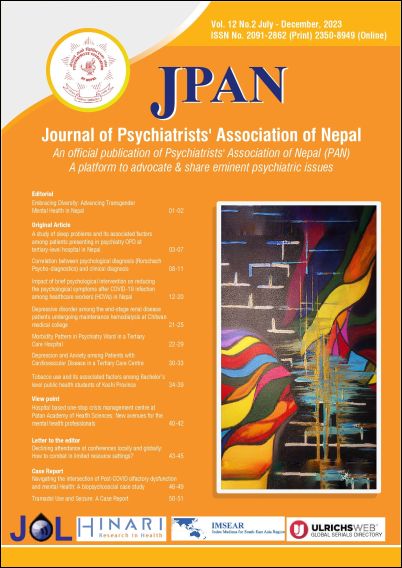Tobacco use and its associated factors among Bachelor’s level public health students of Koshi Province
DOI:
https://doi.org/10.3126/jpan.v12i2.63408Keywords:
Tobacco, cigarettes smoking, GHPSS, Bachelor of public health studentsAbstract
Background: Tobacco is a pressing global public health issue, contributing significantly to widespread illness and mortality. All forms of tobacco consumption have adverse effects on well-being, resulting in millions of deaths each year. Whether through smoking, smokeless methods, or exposure to secondhand smoke, it is associated with various health complications, including cardiovascular diseases, respiratory disorders, diverse cancers, non-communicable diseases (NCDs), and more. The WHO Framework Convention on Tobacco Control underscores the pivotal role of healthcare practitioners like doctors, dentists, nurses, pharmacists, and optometrists in aiding individuals to quit or preventing tobacco usage through concise counseling or straightforward advice. Providing cessation training to aspiring health professionals could be a pivotal stride towards advancing tobacco control endeavors.
Methods: This study employed a descriptive, cross-sectional design to investigate the perspectives of public health students regarding global health issues. Bachelor’s level public health students of Koshi Province were administered the Global Health Professional Student Survey (GHPSS), a validated instrument designed to assess prevalence, attitudes, and behaviors related to tobacco use and control. Data collection took place over a specified time frame, with participants providing responses anonymously. Statistical analyses using SPSS 20 employed to derive meaningful insights into the tobacco consumption habits of public health students.
Results: Out of the participants, 14.1% were identified as current smokers. A significant portion (27.6%) had experimented with cigarettes at some point, with the majority initiating cigarette smoking between the ages of 11 and 19 years. In terms of current usage of alternative tobacco products, 8.2% reported ongoing use, while 9.4% had tried them at least once. Male respondents exhibited a 9.05 times higher likelihood of smoking compared to their female counterparts. Furthermore, individuals with friends who engaged in tobacco smoking were 4.02 times more inclined to smoke than those whose friends did not have this habit.
Conclusion: The research revealed a 14.1% prevalence of current smoking among bachelor level public health students in Koshi Province. As future leaders in health planning and administration, it is imperative for these students to grasp the comprehensive implications of smoking on physical, mental, and societal well-being. To achieve this, academia, healthcare, and policymaking sectors should work in tandem to create an environment that fosters enhanced learning for current public health students. This collaborative effort holds the potential to significantly reduce smoking rates in society.
Downloads
Downloads
Published
How to Cite
Issue
Section
License
Copyright (c) 2023 Journal of Psychiatrists' Association of Nepal

This work is licensed under a Creative Commons Attribution 4.0 International License.
This license enables reusers to distribute, remix, adapt, and build upon the material in any medium or format, so long as attribution is given to the creator. The license allows for commercial use.




